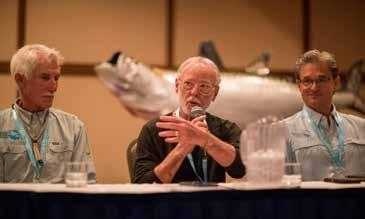
4 minute read
7th International Science Symposium and Flats Expo Promises Research Breakthroughs
BY CHRIS SANTELLA
The theme for this year’s symposium is Conservation Connections, which acknowledges the extent to which bonefish, permit and tarpon move from the waters of one nation to another—itself an important discovery in the 20 years since the first symposium.
Nearly 20 years ago, Bonefish & Tarpon Trust held its first science symposium to diagnose why flats fisheries were in decline and to map initial conservation and restoration plans. This November 12-13, perhaps the most robust gathering of scientists, resource managers, and anglers focused on flats fisheries ever assembled will gather in Weston, Florida, for BTT’s 7th International Science Symposium and Flats Expo. More than 1,000 attendees are expected to hear science presentations, interact with angling experts, meet flats fishing legends, and share stories with fellow bonefish, tarpon and permit enthusiasts.
“The well-being of the flats fishery depends upon our understanding of how the fishery is connected geographically,” said Jim McDuffie, BTT President and CEO. “What happens in one location may potentially impact the fishery in other places far removed from it.”

Captain Steve Huff (left) and BTT board member Sandy Moret (center) spoke on the 2017 International Science Symposium Tarpon Panel, moderated by BTT Secretary Jeff Harkavy (right).
Dan Diez
These conservation connections will also be evident among the scientists at this year’s event. “More than 60 scientists representing the United States, Bahamas, Belize, Brazil, Colombia, Cuba and Mexico will be participating,” according to Dr. Aaron Adams, BTT Director of Science and Conservation. “And their presentations will feature a good deal of new research, including some groundbreaking results from tarpon tracking, permit movements, and some new aspects of bonefish and tarpon genetics.”
One much anticipated presentation will address new findings concerning bonefish reproduction. “I feel like we’re pushing the boundaries of the science with this study,” said BTT collaborating scientist Dr. Paul Wills, Associate Director for Research at FAU Harbor Branch Oceanographic Institute. Dr. Wills, along with Drs. Matt Ajemian and Jon Shenker, is leading a team of 10 researchers. “It’s the kind of project scientists dream of doing in their career. We’ve been able to get bonefish collected from prespawning aggregations in the wild to spawn in tanks, and have been able to get the eggs to hatch and larvae to survive. We’re seeing life stages of these species that no one has ever seen. It’s like walking on the moon the first time.”
Another presentation will look at how contaminants are impacting bonefish populations. “The contaminants that have caught our attention are pharmaceuticals,” said BTT collaborating scientist Dr. Jennifer Rehage, Associate Professor at the Earth & Environment Department at Florida International University. “These are prescription medicines—antibiotics, antidepressants, pain relievers and hormones. Pharmaceuticals are a concern because they are active at low doses, are not removed by conventional water treatment, and remain unregulated (meaning we do not have standards for what are safe levels in the environment). We have found antidepressants and heart medications in bonefish in both South Florida and the Bahamas, and are sampling more bonefish throughout the Caribbean to determine where and how bonefish may be exposed and what it means for them.”

Eric Carey, Executive Director of The Bahamas National Trust, served on The Bahamas Panel at the last Symposium.
Dan Diez
In our media-rich age, there are many ways to share new scientific findings. But it’s hard to overstate the value of likeminded colleagues meeting face to face. “The symposium presents valuable opportunities for networking and sharing experiences,” shared Eric Carey, Executive Director of The Bahamas National Trust, an NGO that is committed to conserving and protecting the Bahamian environment. “We’ve made many contacts at the symposium and have been introduced to key individuals and organizations who either are already working in the Bahamas, or looking for a partner for a conservation or education project.”

Renowned angler Andy Mill shares tarpon tips with attendees of his Tarpon Clinic at the 2017 International Science Symposium and Flats Expo.
Pat Ford
“The symposium is unique in that anglers, fishing guides and scientists come together as a community to discuss what is happening to our fish and how do we make it better,” Rehage added. “I can’t think of another venue where this happens.”
While scientific presentations may be the primary draw, many of the attendees also come to celebrate their love of flats fishing. “From an industry perspective, there’s not a better place to reach people who are passionate about shallow water fishing,” said Chris Peterson, owner of Hell’s Bay Boatworks, and a sponsor of the symposium’s Flats Fishing Expo. “Anyone who’s anyone is there. It’s a conclave of like minds. And since it happens only every three years it’s special, and you want to be sure to be there.”
Peterson, who serves on the BTT Board of Directors, is an active and well-respected conservationist who is quick to emphasize the importance of supporting conservation efforts like those by BTT. “Anyone who works in the outdoor industry does it because we’re passionate about it. Those who are passionate are the proper stewards, as we truly care. BTT is on the frontlines of research. By supporting their work, we have the best chance of influencing conservation policy with sound science.”
“After all—if you don’t have clean water and fish, you don’t need a high-end fishing boat.”
Chris Santella is the author of 21 books, including the popular “Fifty Places” series from Abrams. He’s a regular contributor to The New York Times, The Washington Post, and Trout.








